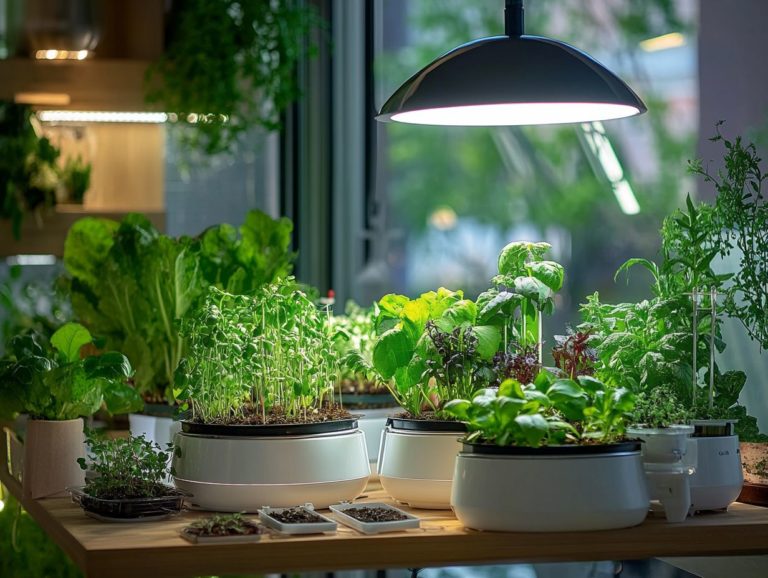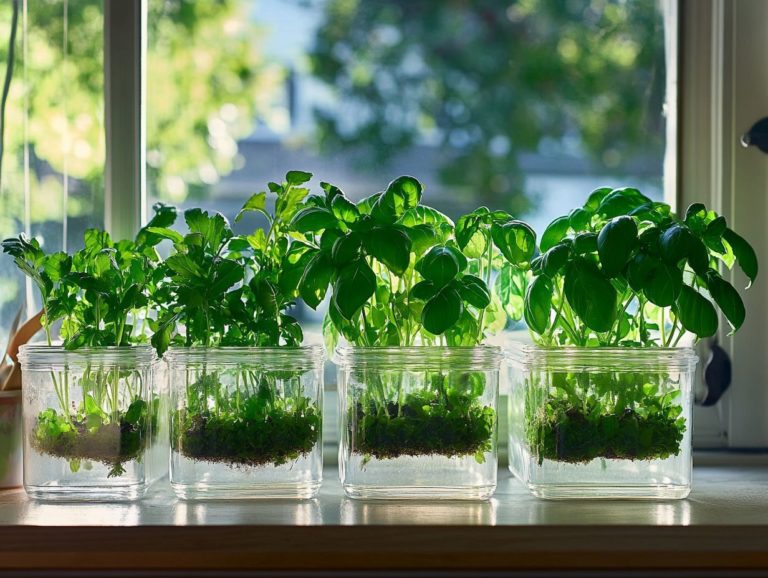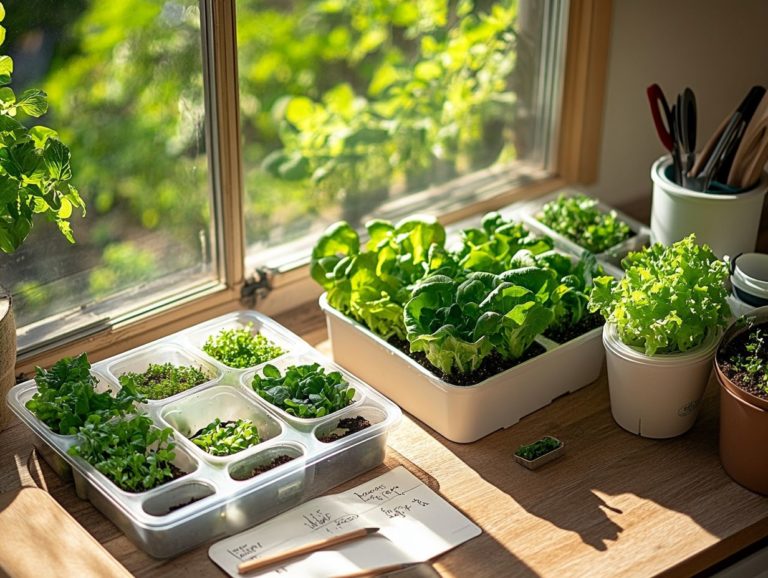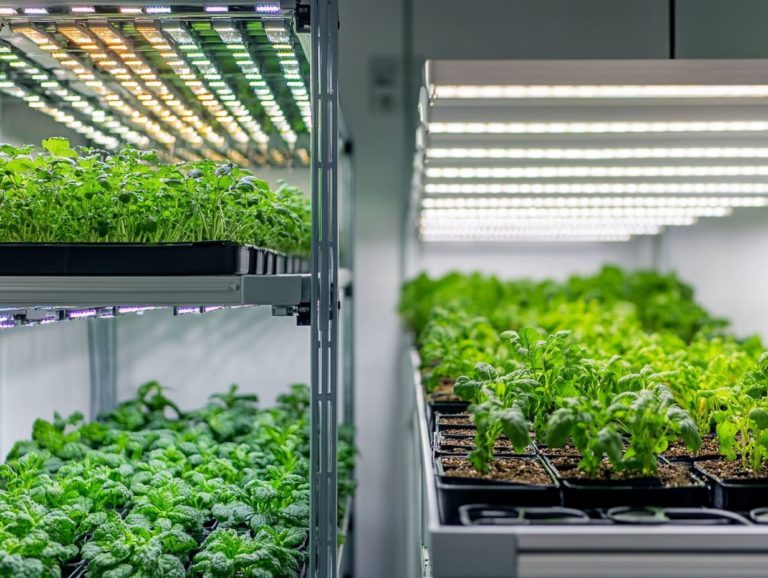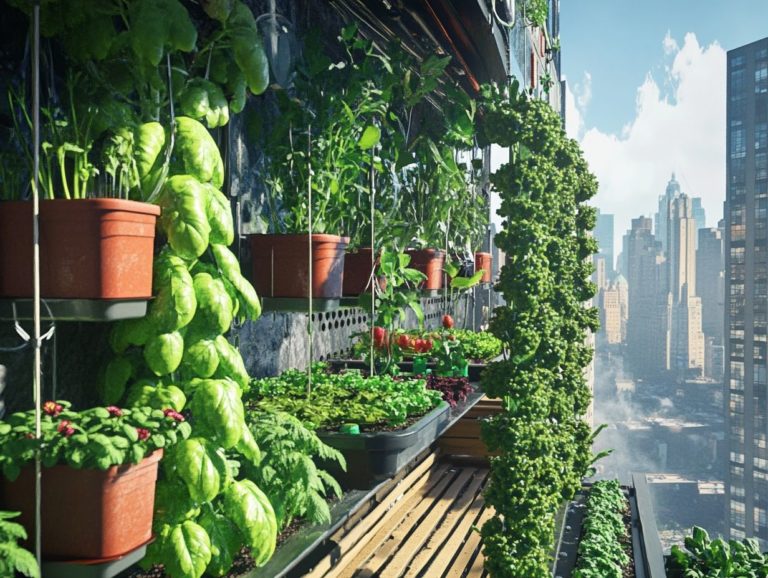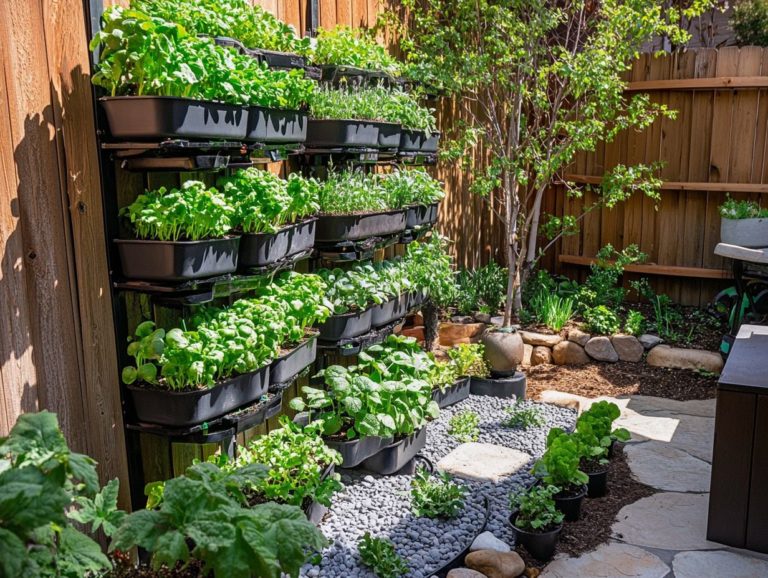How to Create a Hydroponic System for Tomatoes
Ready to transform your gardening? Learn how to grow delicious tomatoes without soil and discover the amazing benefits of hydroponic gardening!
This article explores the art of cultivating these delightful fruits, showcasing the impressive advantages of hydroponic gardening over traditional methods.
You ll receive guidance on selecting the perfect hydroponic system, complete with step-by-step instructions for setup, ensuring your plants flourish.
Discover expert tips to harvest your tomatoes at their peak flavor. Embrace this journey and elevate your gardening game!
Contents
- Key Takeaways:
- Benefits of Growing Tomatoes Hydroponically
- Choosing the Right Hydroponic System for Tomatoes
- Types of Systems and Factors to Consider
- Setting Up a Hydroponic System for Tomatoes
- Materials and Step-by-Step Instructions
- Caring for Your Hydroponic Tomato Plants
- Harvesting and Using Your Hydroponic Tomatoes
- Frequently Asked Questions
- What materials do I need to create a hydroponic system for tomatoes?
- Can I use any type of container for my hydroponic system?
- How often do I need to change the nutrient solution in my hydroponic system?
- What type of growing medium is best for tomato plants in a hydroponic system?
- Do I need to provide additional lighting for my hydroponic tomato plants?
- How long does it take for tomatoes to grow in a hydroponic system?
Key Takeaways:
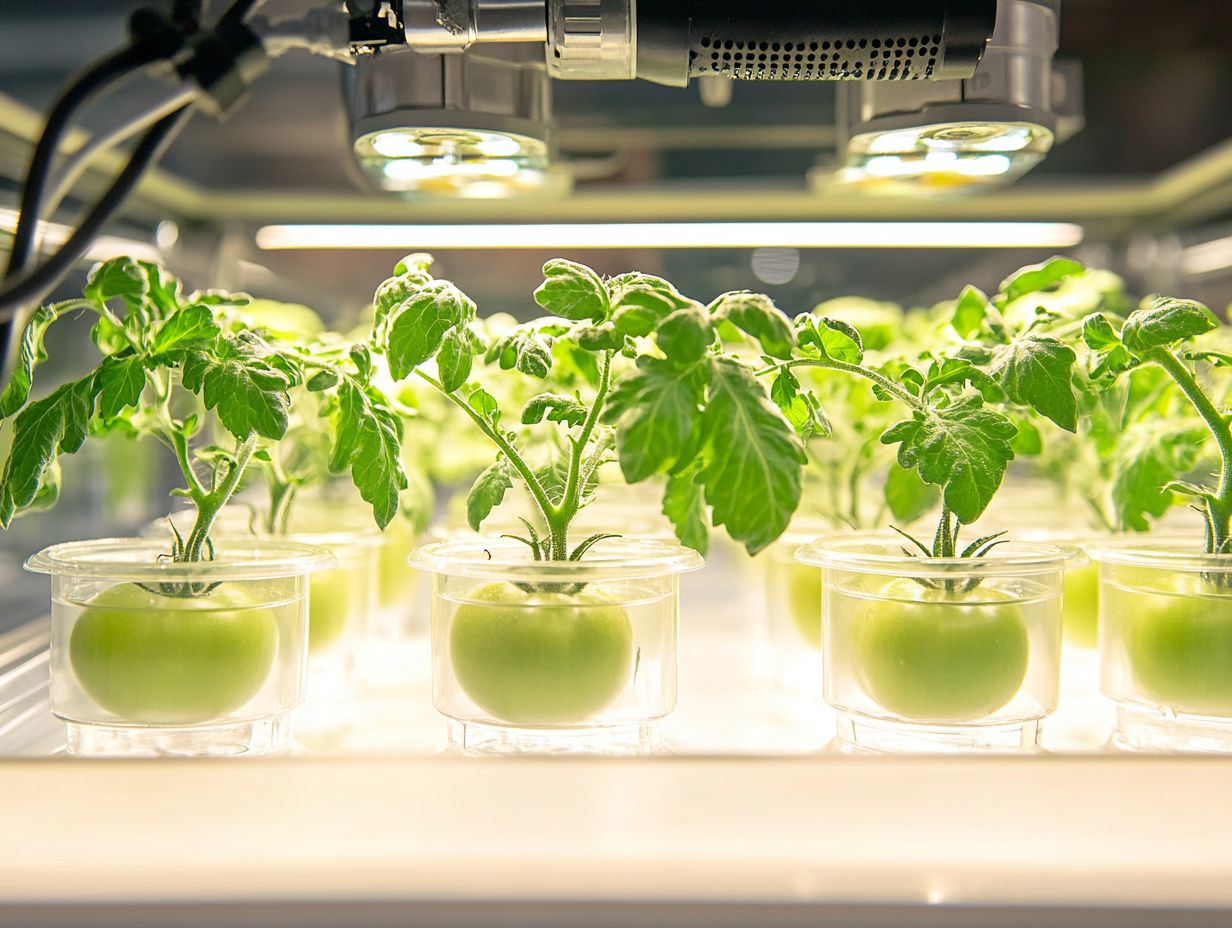
- Hydroponic gardening is a method of growing plants without soil, using water and nutrients instead.
- Growing tomatoes hydroponically offers better control over nutrients, water usage, and space efficiency.
- When setting up a hydroponic system for tomatoes, consider the type of system, materials needed, and proper care for optimal yield and flavor.
What is Hydroponic Gardening?
Hydroponic gardening is an innovative way to grow plants, like cherry tomatoes, without the need for soil. Instead, you’ll use nutrient-rich water solutions to deliver essential minerals directly to the plant roots.
With various hydroponic systems at your disposal, such as Deep Water Culture and Nutrient Film Technique, you can ensure optimal growth in controlled environments. This makes hydroponic gardening an excellent choice for indoor cultivation and urban gardening.
By eliminating soil, you ll achieve higher yields and faster growth rates while conserving water, making this method not just efficient but also environmentally sustainable.
As you explore the evolution of hydroponic gardening, which stretches back to ancient civilizations and gained momentum through 20th-century discoveries, you’ll find it’s increasingly popular among modern agriculturalists.
Unlike traditional gardening methods that depend on soil, hydroponics enables you to produce healthier plants, free from the pests and diseases typically found in soil environments.
With nutrient solutions, you can customize your feeding regimen, ensuring plants like cherry tomatoes receive precisely what they need for robust development.
Various hydroponic systems, such as Ebb and Flow and Aeroponics, provide the versatility to cater to different spaces and preferences. This adaptability not only maximizes your yield but also gives you the power to cultivate fresh produce year-round, even in limited spaces.
Benefits of Growing Tomatoes Hydroponically
Growing tomatoes hydroponically, especially beloved varieties like Sweet Million and Sungold, presents a wealth of advantages over traditional soil gardening.
With hydroponic systems, you gain precise control over nutrient delivery, resulting in healthier plants and a lower risk of disease. This method is particularly useful for cultivating cherry tomatoes in compact hydroponic gardens, where space and resources might be limited. For those interested in this approach, learning how to design a hydroponic greenhouse can be incredibly beneficial.
Advantages Over Traditional Soil Gardening
Hydroponic systems offer a range of benefits over traditional soil gardening, especially for growing cherry tomatoes. They effectively eliminate many challenges tied to soil-based cultivation.
By using a nutrient solution that allows for precise monitoring of pH levels, you can ensure your plants receive optimal nutrition. This attention to detail leads to faster growth rates and higher yields compared to conventional methods.
These systems grant significant control over growing conditions, enabling you to regulate light, temperature, and humidity specifically for cherry tomatoes. If you’re interested in exploring hydroponics further, check out this guide on how to start a hydroponic herb garden. Hydroponic methods generally use less water than soil gardening, thanks to efficient closed-loop systems that recycle moisture.
With no soil to contend with, the risk of pests and diseases is reduced, meaning you ll rely less on chemical pesticides and promote healthier plants.
Equipped with tools like pH testing kits, you can easily maintain the ideal environment for robust growth, ensuring your cherry tomatoes thrive without the typical setbacks encountered in conventional gardening.
Choosing the Right Hydroponic System for Tomatoes
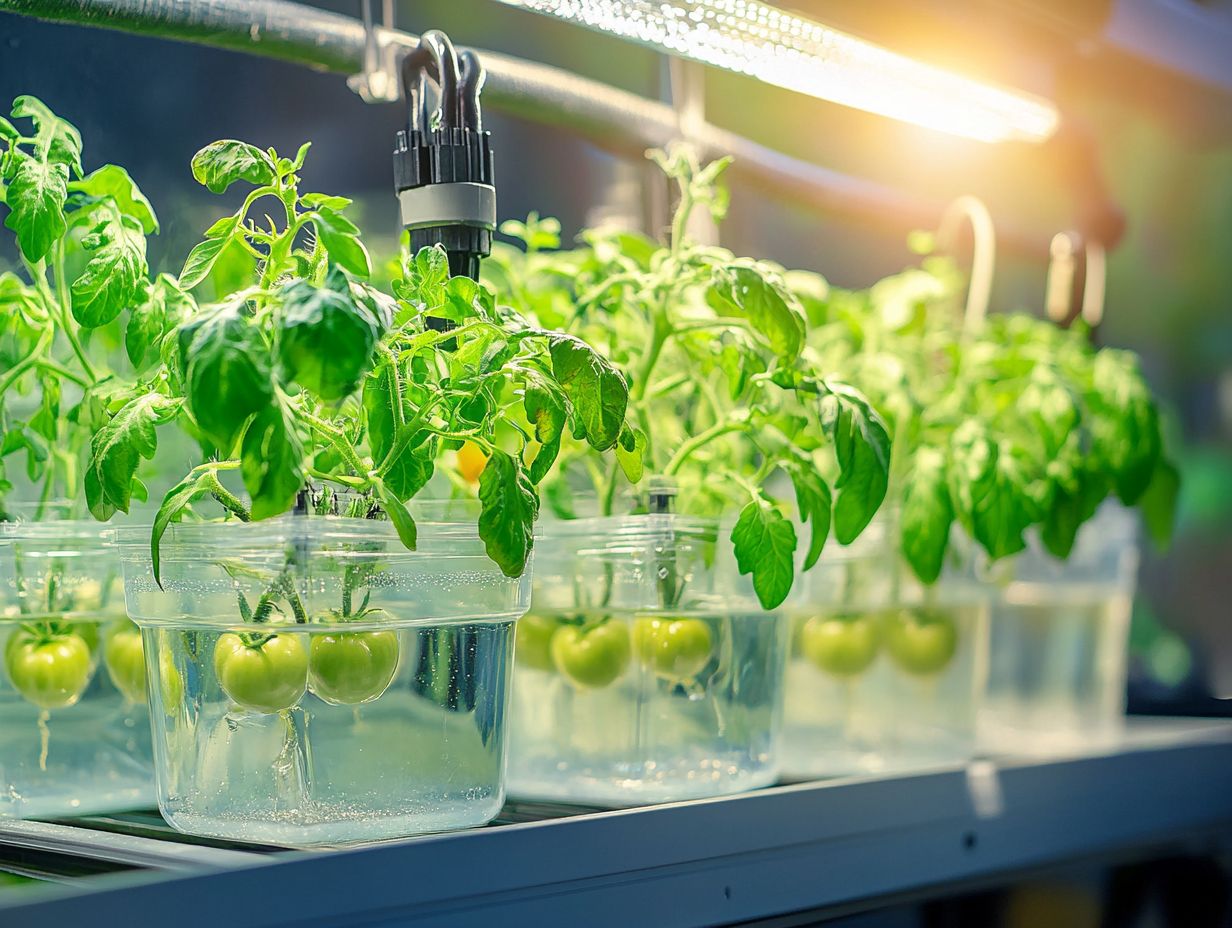
Choosing the right hydroponic system for cultivating tomatoes, such as the beloved Gardeners Delight and Red Robin varieties, is essential for successful crop production.
Hydroponic systems come in various forms. Nutrient Film Technique, Deep Water Culture, and Ebb and Flow are just a few examples. Each system offers unique advantages tailored to different growing conditions and your personal gardening preferences, ultimately facilitating the optimal growth of cherry tomatoes and other tomato seedlings.
Types of Systems and Factors to Consider
When exploring hydroponic systems for growing tomatoes, it s crucial to assess the various options available. Deep Water Culture, Aeroponics, and Drip Irrigation Systems each showcase unique characteristics. Your decision will depend on factors such as available space, budget constraints, and the specific requirements of the tomato varieties you wish to cultivate. This thoughtful evaluation will help you establish an effective setup for your hydroponic garden.
Deep Water Culture stands out for its simplicity. It allows roots to bask in nutrient-rich water, promoting rapid growth. If space is limited, Aeroponics might be your best option; it uses misting techniques to deliver nutrients and works wonders with its vertical growing layout. On a larger scale, Drip Irrigation Systems offer remarkable control over water and nutrient delivery, making them ideal for expansive projects.
By understanding the functionalities of these systems and recognizing their suitability for different scenarios, you can confidently choose the hydroponic system that will yield luscious tomato varieties, optimizing your harvest and nurturing healthier plants.
Setting Up a Hydroponic System for Tomatoes
Setting up a hydroponic system for growing tomatoes like Tumbling Tom or Yellow Pear involves several essential steps.
- Begin by selecting the right water-holding container that suits your space and needs.
- Next, choose an appropriate growing medium that will support your plants effectively.
Your system must support your plants effectively to help them thrive! Consider incorporating artificial lighting if necessary. By doing so, you’ll create an ideal environment for your tomato seedlings to thrive, whether you’re cultivating indoors or managing a cozy hydroponic garden.
Materials and Step-by-Step Instructions
To successfully set up your hydroponic system for tomatoes, you’ll need a few essential materials: a reliable hydroponic system, a nutrient solution, and a pH testing kit to monitor nutrient levels. Adopting a step-by-step approach ensures that your tomato seedlings thrive in the optimal environment, whether you’re using a Nutrient Film Technique or a Deep Water Culture setup.
Gather components like growing media, water pumps, and reflective materials to enhance light distribution. Start by assembling the system according to the manufacturer’s guidelines, ensuring that all connections are secure to prevent leaks. For more detailed instructions, check out this guide on how to get started with hydroponic systems.
Regularly monitoring nutrient solutions is vital. Striking the right balance will encourage vigorous growth and fruiting. Check pH levels frequently to adjust nutrient concentrations. This is essential for preventing deficiencies and promoting healthy plants. By maintaining these parameters, you can expect robust and fruitful tomato plants flourishing in your hydroponic garden.
Caring for Your Hydroponic Tomato Plants
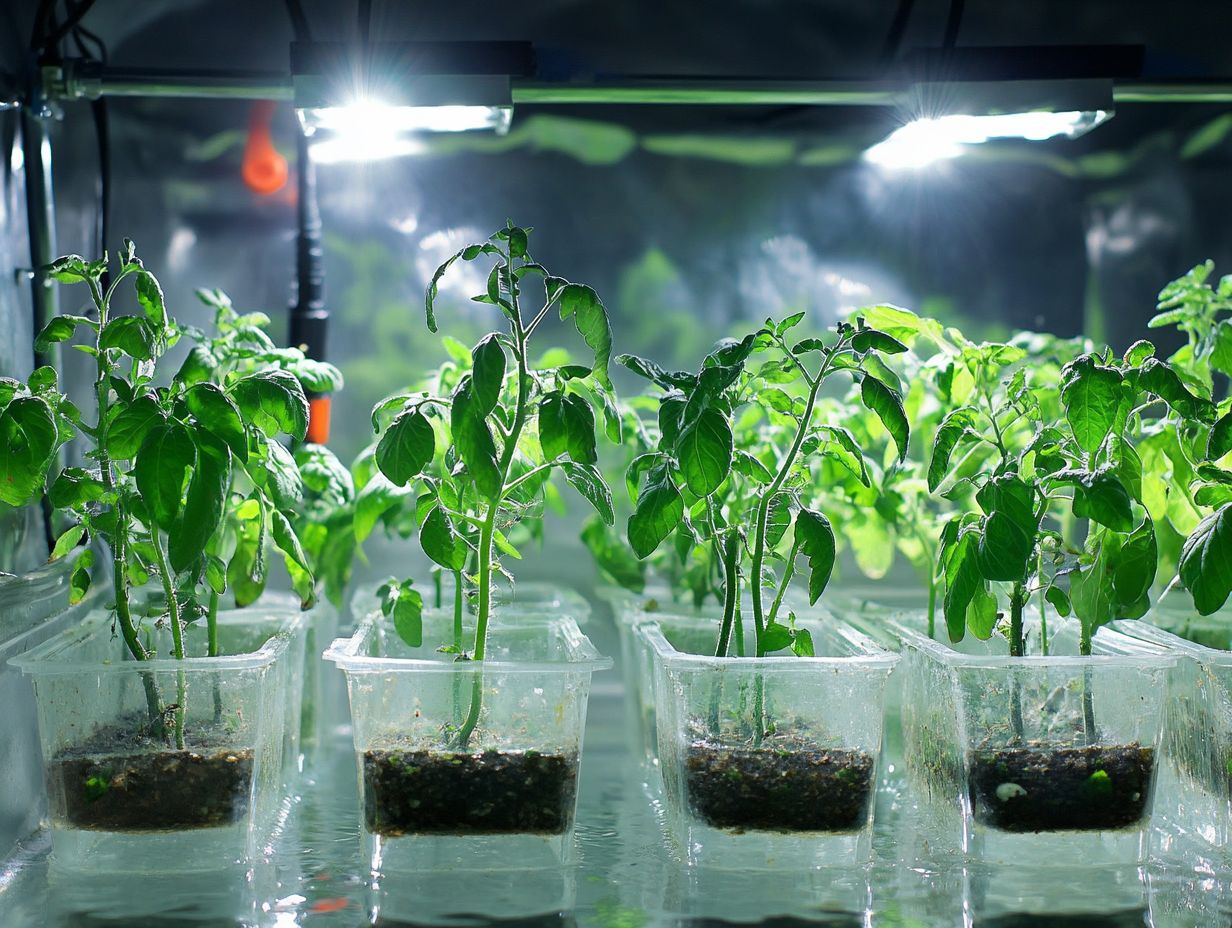
Caring for your hydroponic tomato plants requires a commitment to regular maintenance and vigilant monitoring of nutrient solutions. Ensure that each plant reaches its fullest potential in growth and flavor.
Using tools such as an electrical conductivity meter can help you accurately assess the nutrient strength in your hydroponic system, significantly enhancing plant health.
Adhering to essential maintenance tips will help you sidestep common pitfalls and ultimately improve your yield.
Start your hydroponic journey today! With the right system and care, you ll enjoy a bountiful harvest of delicious tomatoes that you ve nurtured from seed to fruit.
Nutrient Solutions and Maintenance Tips
Caring for your hydroponic tomato plants starts with selecting the right nutrient solution. This choice greatly influences both growth and the quality of your fruit.
Regularly using a pH testing kit and monitoring electrical conductivity keeps your hydroponic system balanced. This ensures your tomatoes receive the essential nutrients they need to thrive.
You’ll find various nutrient solutions available, from pre-mixed formulations designed specifically for tomatoes to customized blends for different growth stages. While formulating these solutions, consider the essential nutrients that plants need in larger amounts, like nitrogen, phosphorus, and potassium, alongside vital micronutrients such as calcium, magnesium, and iron.
Regular maintenance is crucial. Maintaining optimal pH levels, typically between 5.5 and 6.5, ensures nutrient availability. Monitoring electrical conductivity helps gauge nutrient concentration and prevents over-fertilization. For more tips, check out this guide on how to use hydroponics for indoor gardening, allowing your hydroponic tomatoes to flourish.
Harvesting and Using Your Hydroponic Tomatoes
To truly enjoy the fruits of your labor with hydroponic tomatoes like the delightful Red Robin and the flavorful Gardeners Delight, understand the best times to harvest for the finest flavors!
By timing your harvest and using the right techniques, you can elevate the taste and quality of your hydroponically grown tomatoes, ensuring they reach their peak perfection just when you’re ready to savor them.
Tips for Optimal Yield and Flavor
To unlock the ultimate yield and flavor from your hydroponic tomatoes, pay attention to essential factors like the growing medium and the effectiveness of artificial lighting in your setup. Embracing best practices in these areas will significantly enhance the overall health and taste of your hydroponically grown cherry tomatoes.
Selecting the right growing medium, such as coco coir or rock wool, improves aeration and moisture retention, ensuring your roots thrive. Using full-spectrum LED lights mimics natural sunlight, promoting vigorous growth at every stage of development.
It s vital to monitor nutrient levels accurately; a balanced mix of nitrogen, phosphorus, and potassium supports growth while enhancing the flavor of your fruits.
Regular pH testing of your nutrient solution is key to maintaining a healthy environment. This practice promotes nutrient availability and helps prevent deficiencies. Implement these techniques today for an impressive harvest of sweet, flavorful tomatoes!
Frequently Asked Questions
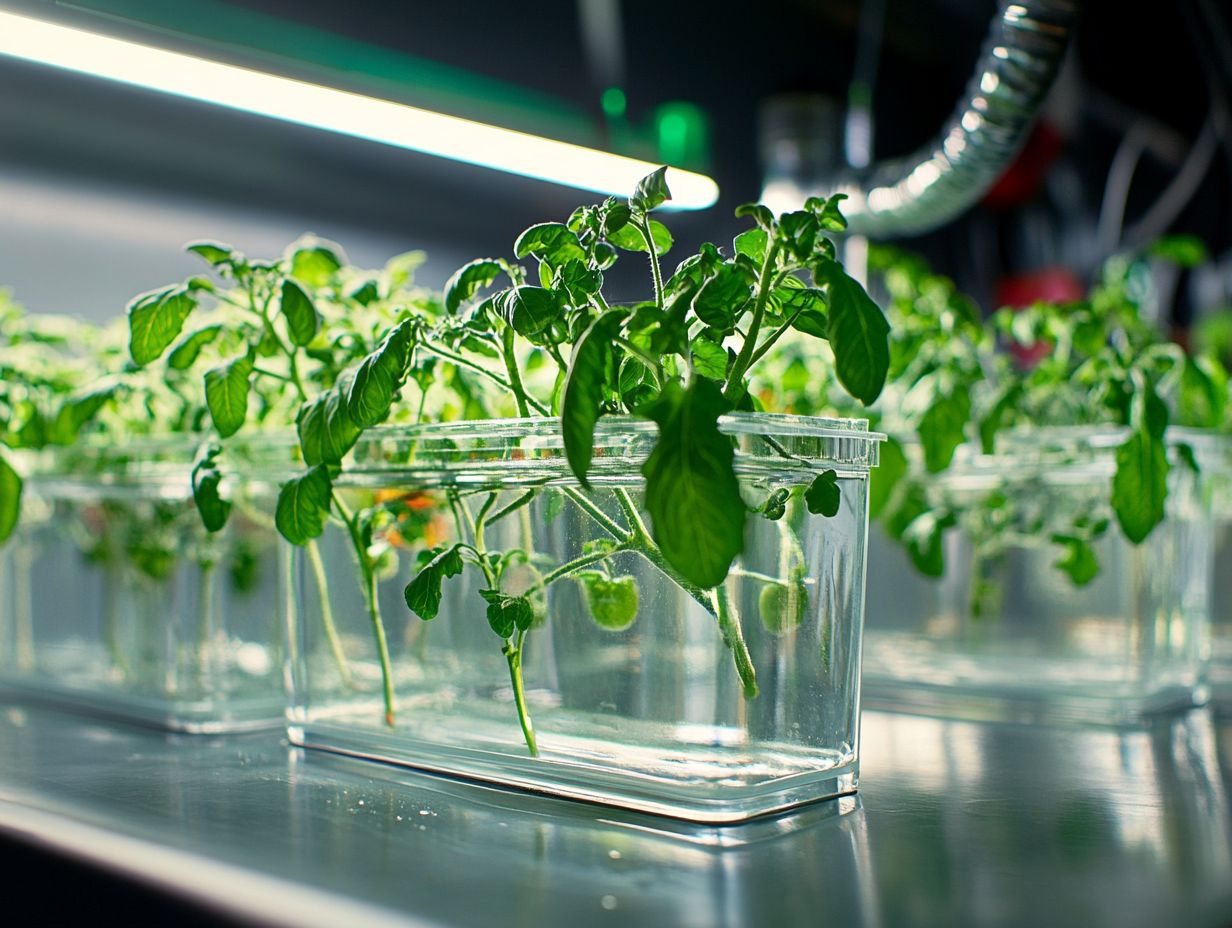
What materials do I need to create a hydroponic system for tomatoes?
To create a hydroponic system for tomatoes, you will need a large water-holding container, nutrient solution, growing medium, net cups, tomato seedlings, and a water pump.
Can I use any type of container for my hydroponic system?
Yes, you can use any type of container as long as it is large enough to hold your tomato plants and has drainage holes at the bottom. Many beginners start with simple hydroponic systems before moving to more complex setups.
How often do I need to change the nutrient solution in my hydroponic system?
The nutrient solution should be changed every 1-2 weeks, or whenever pH levels become unbalanced, to ensure optimal growth and health of your tomatoes.
What type of growing medium is best for tomato plants in a hydroponic system?
Coco coir, perlite, and vermiculite are all great options for growing medium in a hydroponic system for tomatoes, each offering unique benefits for various tomato varieties.
Do I need to provide additional lighting for my hydroponic tomato plants?
Yes, tomato plants require at least 6-8 hours of sunlight or artificial lighting per day. You can use fluorescent lights or LED grow lights, especially full-spectrum ones, for your hydroponic system.
How long does it take for tomatoes to grow in a hydroponic system?
The time it takes for tomatoes to grow depends on the type you’re planting, like Red Robin or Tumbling Tom. Typically, you can expect them to start producing fruit in about 6-8 weeks.
With proper care, you can enjoy a steady supply of fresh tomatoes throughout the growing season. Imagine the satisfaction of harvesting your own juicy tomatoes right from your compact hydroponic garden!

